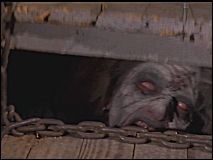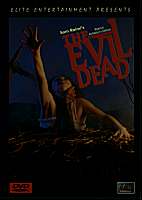![[Deep Focus]](../../../flicker/dvd/logo.gif) |
|||
|
THE EVIL DEAD |
|
Written and directed by Sam Raimi Produced by Robert G. Tapert Cinematography by Tim Philo Edited by Edna Ruth Paul Starring Bruce Campbell USA, 1982
| |
|
In many ways, The Evil Dead is a desperately bad movie. The story is contrived. The dialogue is ho-hum. The continuity is awful, partly because many of the scenes were shot out of sequence by months or even years. (Principal photography took place in 1979 and 1980, but the film didn't see theater screens until 1982.) When the original six-week shooting schedule ballooned into 12, the hired actors began taking off to get their lives back and the filmmakers were forced to use local talent -- stand-ins wearing bad wigs -- for certain shots. In key action sequences, the glaring substitution of prosthetics and puppet heads for live actors is all too obvious. Many of the special effects aren't very special. For most of the movie, the actors' performances are -- well, "unconvincing" would be a polite way to put it. But none of that matters. In fact, all of the flubs, the bad edits, and the cheesy matte shots are key elements of a low-budget aesthetic that enhances the movie's impact even as it makes excuses for itself. (It may have that much in common with this year's Sundance cause celebre, The Blair Witch Project.) A credit at the very end describes the film as "the ultimate experience in grueling horror," and it's that kind of cockiness, combined with the game, can-do attitude of everyone involved, that makes The Evil Dead such a hoot.
Raimi didn't hit his nadir, however, until TriStar released The Quick and the Dead (1995), a slick but flat Sergio Leone knock-off starring Sharon Stone, Gene Hackman, and Leonardo DiCaprio -- Raimi's real mainstream debut. Give him credit, then, for following it up three years later with the engrossing, sharply observed character study A Simple Plan, carefully adapted by screenwriter Scott Frank from his own novel. Twenty years after securing financing for his on-the-cheap zombie debut, Raimi helmed a film with Oscar nominations for both performance (Billy Bob Thornton) and screenplay. Of course, I still prefer the zombie debut. We'll have to see how A Simple Plan holds up over time, but The Evil Dead looks like one for the ages. The filmmakers admit to deriving a large degree of inspiration from Tobe Hooper's 1974 ripsnorter, The Texas Chain Saw Massacre. Like Chain Saw and the subsequent Friday the 13th series, The Evil Dead takes place in a state of isolation that's peculiar to American notions of solitude and freedom -- a cabin in the woods, accessible from civilization only by a ramshackle bridge. (Compare to John Carpenter's Halloween, which ratcheted up the paranoia factor by placing unknowable evil right in the middle of suburbia.) Enter a group of five college kids (three girls, two boys), who arrive at the cabin for a brief getaway. But as night falls, weird things start happening. The pendulum on a grandfather clock stops swinging. Cheryl (Ellen Sandweiss) begins drawing strange pictures in her sketchbook, against her will. And there's a strange howling noise coming from the woods outside. It takes some time for The Evil Dead to start moving -- it actually pauses for character development before kicking into gear -- but once it does, it moves frantically. The first major set piece comes when Cheryl ventures outside, unwisely, to investigate those strange noises. She ventures too far into the woods, calling out into the darkness and thus drawing attention to her vulnerability (as girls in horror movies do). Abruptly and brutally, in a scene inspired in part by Macbeth, she's assaulted and raped by the trees. Yes, you read that right, and I suppose a few of you can stop reading now, secure in the knowledge that the ultimate experience in grueling horror is not, after all, your cup of tea. Of all the gruesomeness in this very gory film, it's this very abstract violation that feels most transgressive. Dramatically, it gives malevolent presence to the otherwise unseen and unembodied "force" lurking out in the woods, and puts the audience on alert that anything can happen in subsequent scenes. It also has the important effect of negating any urge to take the film lightly because of its roughness -- this is fairly disturbing stuff, and it's not being played for laughs. With the film's horror cred thus established, Raimi sets to the task of making a straightforward living dead flick. Once Cheryl makes it back into the cabin, she metamorphoses quickly into a blank-eyed zombie who attacks her former friends. The others get her into the cellar, where she spends much of the rest of the film peeking out and taunting the others as she strains against the chains holding the wooden door closed. In the struggle, unfortunately, one of the other girls has been stabbed, and her condition is deteriorating fast. From that point on, the stops are pretty much out. Naturally, the bridge has collapsed (or has been wrecked), so our protagonists are stuck in the cabin. As George Romero taught us all so well, zombies beget zombies, so it's in the best interests of those still living that the living dead be kept under wraps. Unfortunately, the characters aren't very good at this, and fall one by one under the possession of that evil force howling through the woods. What made this film unusual in its day was the sheer volume of gore lavished upon the hand-to-hand fight sequences between humans and zombies. The zombies don't just die -- they must be dismembered, at which point blood and milk and oatmeal spurt and ooze from every orifice and gaping wound. What makes it still work today, after directors like Stuart Gordon and Peter Jackson have one-upped it on just about every gruesome count, is its crackerjack sensibility, embodied in bizarre camera angles, artful film editing style, and relentless forward motion. The amount of window-breaking, furniture-smashing energy expended on making this film only testifies to the filmmakers' own crazy dedication and immersion in the low-rent alternate reality they were creating. I mentioned earlier that the performances are mostly lacking, but all three women really come through when it's time to play the undead harpies demanded by the script. Betsy Baker's grinning clown-faced demon, taunting "We're gonna get you," is one of the more enduring images of the (quite literal) femme fatale in contemporary film. And at the film's climax, the special effects suddenly become more ambitious, with extensive stop-motion animation, optical effects, and ingenious cutting contributing to the delirium. The last 10 minutes in particular are one of the great roller-coaster rides in the history of low-budget filmmaking. Much as I hate to admit it, they predate Peter Jackson's Braindead, which I love, by about a decade. The bottom line is that The Evil Dead is a fun movie. I think it's also a scary movie -- back in the 80s, I used to enjoy showing my VHS copy of this to anyone who would sit through it, just to see how far they jumped out of their chairs at the film's two or three very effective shock scenes. But there's more to it than cheap scares. The roughness of the production somehow makes it more involving, and more legitimate. For all its Grand Guignol gimmickry, I always remembered The Evil Dead more as though it were a documentary record of an event than just a goofy low-rent horror knock-off. It feels exactly that grimy and unmannered, a paradox considering the extreme self-consciousness of some of the camerawork. Elite Entertainment has just released a new DVD special edition of the film, which reproduces the original 16mm film image with startling clarity and color fidelity, warts and all -- indeed, in my many prior viewings, I had never noticed the glaringly theatrical make-up worn by the possessed girlfriends, or some of the roughly hewn double-exposure tricks at the end of the film. Some of these scenes are soft and/or grainy, always a challenge for DVD's digital compression algorithms, but the disc looks pretty good on the whole. Unfortunately, the textures of some of the darker scenes go completely inert, a side-effect of the compression process. Despite these caveats, the DVD is a welcome improvement on all previous video versions of the film (I can't comment on the no-frills edition released previously by Anchor Bay; it reportedly uses the same transfer, so the only difference would be in quality of the digital compression). In addition, the sound has been remixed for this release, and the DVD offers both 5.1-channel and two-channel Dolby Digital soundtracks. As a purist, I would have preferred that the original mono soundtrack be included as an option, but I have to admit that the remixes sound pretty good -- better, for instance, than the rather thin 5.1 sound on Elite's previous laserdisc and DVD release of The Texas Chain Saw Massacre (which included the original mono track as an option). Supplementary material on the Elite disc consists of two commentary tracks, a gallery of production stills, and some interesting raw footage, mostly of the actors in zombie regalia responding to off-camera direction from Raimi. The commentary tracks are typical of too many DVD efforts -- rather than interviewing the subjects in-depth, editing many hours of tape down to a movie-length track (the method employed by The Criterion Collection and the best studio projects), Elite apparently just plopped the participants down in front of a video monitor and told them to start talking. Bruce Campbell handles this very well, narrating the film with the aplomb befitting a cult favorite who's spent a lot of time discussing the film with fans over the years. He tells brief anecdotes about making the film, identifies the biggest jumps backward and forward during the actual filmmaking process, and identifies the occasional on-screen goof or flubbed line. At times, Campbell had me laughing out loud -- since I was sitting alone in the TV room at the time, consider that a ringing endorsement of at least part of this track. Unfortunately, it's buttressed by a second commentary, from Raimi and producer Robert Tapert, that covers much of the same ground with more stretches of silence and considerably less wacky charisma. I gave up on this one after about a half-hour, so it's possible that it gets much better, but who has time to figure that out? In addition, the sound has been remixed for this release, and the DVD offers both 5.1-channel and two-channel Dolby Digital soundtracks. As a purist, I would have preferred that the original mono soundtrack be included as an option, but I have to admit that the remixes sound pretty good -- better, for instance, than the rather thin 5.1 sound on Elite's previous laserdisc and DVD release of The Texas Chain Saw Massacre. | |||
| |||



 http://www.deep-focus.com/flicker/
bryant@deep-focus.com
http://www.deep-focus.com/flicker/
bryant@deep-focus.com